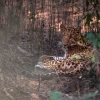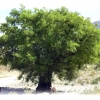Sayantani Chatterjee: How was the reintroduction of the greater one-horned rhinoceros carried out in Manas National Park?
Deba Kumar Dutta: The greater one-horned rhinoceros, also known as the Rhinoceros unicornis, constitutes one of the key species as well as a charismatic species of Manas National Park. Manas was once a home to a population of more than 180 rhinos but the entire population was wiped out during the ethnic unrest between 1988 and 2001. The entire rhino population of Manas was rendered locally extinct. Since the early part of 2000, there has been a restoration of peace in the area aided by the formation of the Bodoland Territorial Council (BTC) for local governance. This has led to the restoration of conservation efforts at Manas.
Under the rescue and rehabilitation programme initiated by the government of Assam in collaboration with the Wildlife Trust of India (WTI), Bodoland Territorial Council and International Fund for Animal Welfare (IFAW), nine orphaned rhino calves were reintroduced to Manas National Park between the years 2006 and 2014. Calves were kept in a 5.7 hac area enclosure (Boma) for about two and a half years for acclimatization and thereafter they were released into the wild.
Indian Rhino Vision-2020 (IRV-2020) is a joint programme for the long-term conservation of the greater one-horned rhino in Assam. It has been developed and implemented by the Forest Department, Government of Assam, World Wildlife Fund (WWF) and International Rhino Foundation (IRF) and is supported by a number of organizations including US Fish and Wildlife Services (USFWS), Bodoland Territorial Council (BTC) and WADWT. The programme aims to increase the population of the greater one-horned rhino by 3000 in new/ potential areas, all throughout the state of Assam, by the year 2020. As part of IRV-2020 rhino population range expansion strategy, 18 rhinos were translocated from Pobitora Wildlife Sanctuary and Kaziranga National Park to Manas National Park between the years 2008 and 2012. For a viable and stable population of greater one-horned rhino at Manas National Park, it is essential to maintain a minimum of 40 rhinos with a sex ratio of 3:1. The remaining rhinos required in different phases of the project will be brought from Pobitora Wildlife Sanctuary and Kaziranga National Park.
S.C.: What is translocation and why is it significant?
D.K.D.: Translocation is the intentional release of a species into the wild in an attempt to establish, re-establish or augment the population. Translocations have been used to establish population of non-native species and restore native species extirpated due to poaching or hunting (Griffith et al. 1989).
Due to high human densities and extensive settlements, sufficiently large areas of suitable and secure habitats for range expansion are limited in many parts of Asia and Africa. In Asia, opportunities for intense biological management for the rapid growth of rhino population are limited. However, the greater one-horned rhinoceros range has been expanded at minimum level in Nepal and India through the process of translocation.
With successful conservation, the numbers and densities of greater one-horned rhinoceros have been increasing. To maintain metapopulation growth and productivity in these populations, larger areas with new range are required (Emslie et al. 2009). The new potential sites of rhino habitat need effective protection so that newly introduced rhinos can survive for a longer period.
S.C.: How successful was the process of translocating the rhinos to Manas?
D.K.D.: The rhino translocation programme at Manas National Park was a landmark in the history of rhino conservation in Assam. There was no occurrence of causalities or damage during the process of translocation. It has been more than eight years since the start of the rhino reintroduction program in Assam. Since then, the programme has contributed to the overall development of Manas National Park. The programme began by improving the security infrastructure at the park, initiating the process of revival of the park. As a result of these efforts, the park got back its status as a UNESCO World Heritage Site in 2011. Today Manas has 30 of the wild population with 14 new-born calves. The newly-established rhino population of Manas National Park form 0.8 percent of the global population
S.C.: What were the methods used for tracking the rhinos?
D.K.D.: Following their release, the rhinos were closely monitored through radio tracking and direct observation to record their colonization pattern and behavioral adaptation and habitat utilization. ArcGIS 9.2 and ArcView 3.2a (ESRI 2006) was used to plot and analyze spatial data.
S.C.: Based on the tracking, could you tell us something about the behaviour of rhinos?
D.K.D.: Just after their release, the rhinos were found to be explorative in their behaviour. There has been behaviour variation observed among adult males, adult females and rhino calves just after their release as well as with changes in the seasons. There is no drastic difference between behaviour patterns of reintroduced rhinos and rhinos found in other areas of Assam and Nepal. Rhinos’ overall behaviour budgeting, gradual decrease of stray pattern and birth of 14 newborns in the last three years indicated that the re-introduced rhino population adapted well in Manas National Park.
S.C.: Is there any poaching threat to the reintroduced rhinos?
D.K.D.: Yes. Rhino conservation initiatives at Manas National Park faced a major setback when eight adult rhinos were poached within a period of three years (2011 to 2014).
One of the factors that makes poaching possible is the straying of rhinos. What can be done to prevent the straying of rhinos? Installation of solar electric fences at the boundaries of the national park, proper monitoring and patrolling, community awareness as well livelihood support may help minimize incidents of straying and poaching of rhinos.
S.C.: Did the reintroduction of rhinos help in the revival of Manas National Park?
D.K.D.: After a long period of social unrest in the early '90s, the rebuilding of Manas National Park has been initiated through the rhino introduction programme (IRV2020). The program is regarded as one of the most successful programmes in the history of conservation in India. It has not only helped the park revive its glory but has also opened new dimensions in conserving this magnificent animal.
Rhinos have helped attract more tourists to the area, thereby contributing to the improvement of the local economy. During 2010-2011, 16,996 tourists visited Manas National Park. A Transboundary Conservation Initiative between the governments of India and Bhutan is underway, with the aim of conserving the bountiful natural resources of Manas National Park, including its rhinos.
S.C.: Have there been other species introduced in Manas National Park?
D.K.D.: Yes. Eastern Swamp Deer (Rucervus duvaucelii) was introduced in Manas National Park from Kaziranga National Park in the year 2014.












